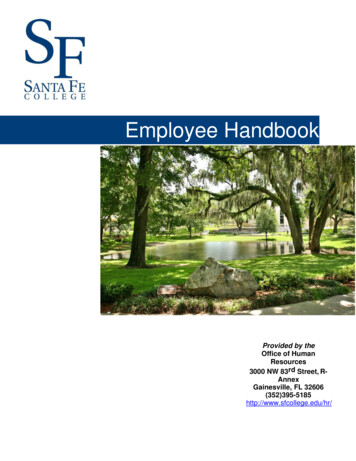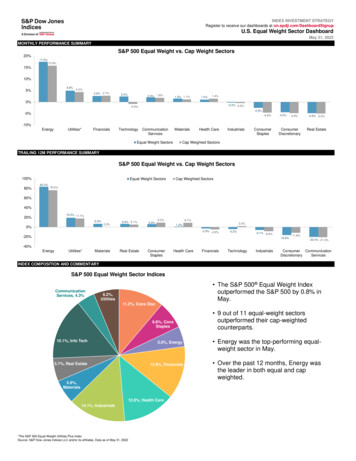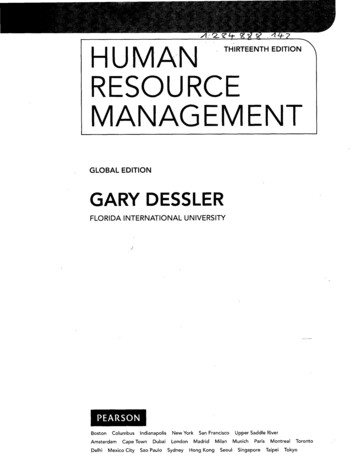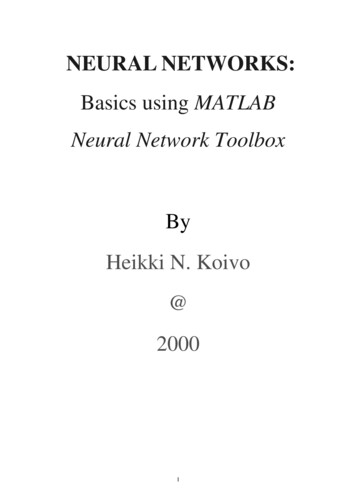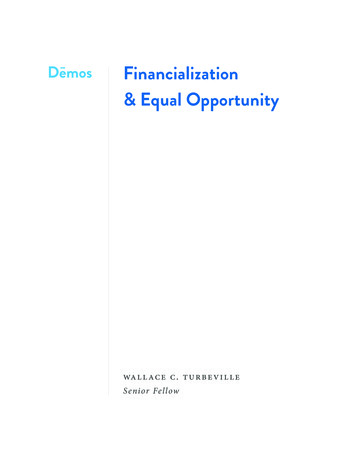
Transcription
Financialization& Equal Opportunitywa l l ace c. turbevilleS enior Fellow
About DemosDemos is a public policy organization working for anAmerica where we all have an equal say in our democracyand an equal chance in our economy.Our name means “the people.” It is the root word ofdemocracy, and it reminds us that in America, the truesource of our greatness is the diversity of our people. Ournation’s highest challenge is to create a democracy thattruly empowers people of all backgrounds, so that we allhave a say in setting the policies that shape opportunity andprovide for our common future. To help America meet thatchallenge, Demos is working to reduce both political andeconomic inequality, deploying original research, advocacy,litigation, and strategic communications to create theAmerica the people deserve.demos.org220 Fifth Avenue, 2nd Fl.New York, NY 10001Media Contactegray@demos.org212.633.1405 ext. 551
TA B L E O F C O N T E N T SIntroduction 1.I. A Faltering Economy 5.II. Financialization and Its Impacts:Basic Observations 9.III. From Finance to Financialization 13.IV. Financialization in Society: Inequalityand the Dynamics of Capitalism 24.V. Financialization and Inequality: WealthAccumulation and Capital Returns 32.VI. Financialization and Inequality: Employmentand Economic Growth Conclusions 44.Conclusions 58.
INTRODUCTIONIn the three decades after World War II, America became thefirst predominantly middle-class country in the world andour poverty rate was cut in half. Americans experienced whatscholars describe as the “Great Compression.” In this era, realaverage compensation rose nearly one-to-one with productivitygains;1 the bottom 90 percent of households (in terms of income)enjoyed most of the benefits of growth over the slightly longerperiod from 1933-1973 (see Figure 1). Inequality of income andwealth in the US was at its low ebb.Over the most recent three and one-half decades, the Great Compression has been almost completely reversed. A large majority ofhouseholds has seen minimal or no real income gains and a substantial minority actually lost ground. Meanwhile a tiny minority of themost affluent households has enjoyed unprecedented income gains,with the richest 1 percent of households capturing nearly 70 percentof income gains between 1993 and 2012 and virtually all of thegrowth since the Great Recession.2 Today our society suffers fromlevels of inequality that threaten to surpass even the extremes of theGilded Age.Of course, the benefits of the Great Compression were distributed unevenly across racial and ethnic categories. On average, whiteAmericans always fared better. By the early 1980’s the wealth ratioFigure 1. Growth Accruing to Each Income Group120%1001933-19731975-2010806040200-20%The Bottom 90%Source: Thomas Piketty and Emmanuel Saez, 20131 demos.orgThe Top 10%
of whites to African-Americans was 12-to-1 and the wealth ratio ofwhites to Latinos was 8-to-1. By 2009, these ratios had increased to19-to-1 and 15-to-1 in part due to the disproportionate effects of themortgage crisis caused by the financial sector.3The coming of this second Gilded Age has coincided with anumber of important structural changes in our political economy—today our tax code is significantly less progressive, our highereducation system is less accessible and much more unequal andour unions and labor rights are comparatively much weaker in thestruggle for a fair distribution of wages.4 These structural changeshave been justified as strengthening the private sector to encouragegrowth—growth that supposedly would lift up middle- andlow-income households.Exactly the reverse has unfolded: the rich have gotten vastlyricher, while the majority of Americans have seen no real gains orlost ground. The rationale behind these changes was market-libertarianism and the belief that markets are far more efficient at allocatingcapital among alternative uses than the government.5 If the 2008financial crisis did nothing else, it should have taught us that themarket is not a freestanding, efficient machine that should be set freeto work its magic.Initially, in the wake of the bank bailouts of 2008, much of thediscussion focused on the problem of excessive risk in the financialsystem, culminating in the Dodd-Frank legislation passed in 2010.More recently, researchers and analysts have raised a deeper setof questions about what is termed the “financialization” of oureconomy.Many forces contribute to growing inequalities of income andwealth, but the financial system is the medium through whichthey work and has become a controlling factor. To illuminate thiseconomic transformation, our analysis departs from previous discussions of financial reform by assessing how the evolution of thefinancial sector since 1980, and its expanding role in the economy,interact with other forces in the economy so that wealth is no longercycled into well-paying jobs that raise average living standards andprovide security for ordinary Americans. Instead, wealth increasingly grows only itself, for the benefit of a tiny minority of businessowners and managers and to the detriment of the non-financialeconomy of production, jobs, household earnings and real economicgrowth.Understanding this is important in a practical sense. Contraryto the market-libertarian views held by a large majority of decisionnovember 14 2
makers today, policies aiming to reduce inequalities of wealth andincome may also be more efficient in terms of growth, raising livingstandards over the long term.The compounding increase in inequality driven by weakeconomic growth is a story that leading researchers—most notablyThomas Piketty—see unfolding in the twenty-first century, particularly in the United States.6 Yet, in discussions of America’sgrowing inequality, we often hear that policies designed to promotegreater equality, such as implementing a more progressive taxcode, will backfire because they will reduce investment and “shrinkthe economic pie,” thereby limiting opportunities for lower-income households. Our analysis turns this metaphor on its headby examining how, in fact, the financial system is “shrinking theeconomic pie” for all Americans while simultaneously channelingnearly all of the remaining growth exclusively to the most affluentamong us. Indeed, we argue that financialization is not only a majordriver of growing inequality but also undermines key sources ofgrowth and job creation, effectively transforming our economyinto something approaching a zero-sum game between financialwealth-holders and the rest of America.Basic investment patterns provide a window on what ishappening. Big businesses have increasingly elected to foregoinvestment of profits and newly raised capital in job-creatingenterprise growth and new product lines; instead, they distributecash assets derived from operating profits to shareholders in sharebuybacks, reducing claims on remaining assets.7 Small businessformation and investment have been shrinking for at least a decade,as is government investment—a critical growth engine in the twentieth-century economy—at every level.8 All of these negative trendsare so closely related to financialization that they must be seen asan element of it. Effectively, the real economy is being convertedinto a servant of passive investment that either exploits or bypassesordinary workers and households, with a bottom line of morehousehold debt, shrinking labor incomes, diminishing job securityand weak employment growth for a large majority of Americans.Whether and how America addresses this problem is extraordinarily consequential for our society: Current trends, if left unabated,will likely reduce the median living standard of future generationsfor the first time in American history. Further, as Piketty’s eleganthistorical model of growth and income distribution suggests, thecompounding force of extreme income inequalities will createdynastic wealth, passing between fewer and fewer hands across gen3 demos.org
erations, challenging our fundamental political values.Public policies can diminish and reverse these trends. However,the near-complete destruction of campaign finance limits under theRoberts Supreme Court does not bode well for winning historically effective political solutions to this problem any time soon, suchas taxation of wealth at levels that would make a difference. Thus,reining in financialization, the structure that facilitates inequality, isall the more important. It may also be more politically viable giventhe range of potential stakeholders, including financial stakeholders,who are losing out in an economy designed to grow Wall Street atthe expense of Main Street.In the following report, we make a case for “de-financialization”of our economy, from a standpoint of equal opportunity, increasedmiddle and lower incomes, job creation and sustainable economicgrowth. First, we examine the conditions that have emerged over thelast three and one-half decades in the section entitled “A FalteringEconomy.” The major findings and conclusions of this report aresummarized under “Financialization and Its Impacts: Basic Observations.” Next, in the section entitled “From Finance to Financialization,” we propose a new, more useful definition of financialization and identify its scope and characteristics. In “Financializationin Society: Inequality and the Dynamics of Capitalism,” we exploreincome and wealth inequality and their connections with financialization. From that base of inquiry, we then move on to thetwo elements of inequality, increasing wealth and income of thewealthiest and stagnating wealth and income of the great majorityof households. We analyze the role of financialization in the growingwealth of the very wealthiest Americans under the heading “Financialization and Inequality: Wealth Accumulation and CapitalReturns.” Finally, we explore the relationship between financialization and weak growth of the economy and stagnating incomefrom labor in “Financialization and Inequality: Employment andEconomic Growth.” At the end of this report, findings and conclusions are discussed under “Conclusions.”november 14 4
I . A FA LT E R I N G E C O N O M YMore than six years have passed since the banking crisisof 2008 plunged America into the Great Recessionand its painful aftermath. While the shorter-termcauses of the crisis have been extensively debated, andpartly remedied, policymakers have been slower to grasp the longer-term implications, as reflected in wage stagnation, diminishingjob security, prolonged recovery toward full employment and othereconomic challenges. Aggregate trends paint a picture of macroeconomic decline: Economic growth remains low compared with pre-crash rates.Low growth persists despite unprecedented intervention bythe Federal Reserve to lower interest rates and incentivizecapital investment. Interest rates have lingered close to zerofor an extended period, but U.S. Gross Domestic Productremains close to 10 percent lower than projections for 2014made before the crisis.9 Leading economists suggest thatthe United States may be in danger of falling into “secularstagnation,”10 a condition in which low interest rates cannotignite a virtuous cycle of growth by simulating aggregateFigure 2. Ignition of Virtuous Cycle by Monetary PolicyLow Interest Loansto Governmentand BusinessInvestmentto ExpandProductionOperatingProfitIncreasedWagesof WorkersIncreasedDemandfor Products5 demos.org
demand and investment in business growth (see Figure 2). Economic inequality has grown dramatically in recentdecades, almost entirely due to gains at the top of thedistribution and stagnant growth for all others.11 After a longperiod of stable decline in the U.S., our Gini coefficient12has increased by more than 20 percent since 1980 (seeFigure 3), sharply contradicting Simon Kuznets’ oncecanonical theory that income disparity inevitably narrows inadvanced economies (the “Kuznets Curve”).13 Notably, theKuznets Curve, developed in the 1950s, did not anticipatefinancialization, in any of its manifestations. The financial sector has grown substantially as a share ofGross Domestic Product (see Figure 4).14 This trend is oftenreferred to as “financialization,” but such a definition isboth too broad and too narrow. Beyond the growth of thefinancial sector as defined in GDP terms, financializationencompasses other sectors of our economy, which aredistorted or disinvested in the service of financial returns.Additionally, to be useful, financialization should be definedas financial activity that goes beyond the activity neededto accomplish the core purpose of the financial sector andimpairs the quality of service to that core purpose.Figure 3. Income Gini Ratio of Families by Race of Householder,All Races, Ratio, Annual, Not Seasonally Adjusted.460.440.420.400.380.360.340.320.300’47 ’50 ’53 ’56 ’59 ’62 ’65 ’68 ’71 ’74 ’77 ’80 ’83 ’86 ’89 ’92 ’95 ’98 ’01 ’04 ’07 ’10 ’13Source: Census Bureau, 2014november 14 6
Figure 4. Finance as a Share of GDP9%876543210’59’67’75 ’83’91’99’07’15’23 ’31’39’47 ’55 ’63’71’79’87’95 ’03 ’09Source: Thomas Philippon, 2012These conditions—weakening growth, rising inequality, andfinancialization—emerged concurrently, beginning in the early1980s.15 The latter is demonstrably associated with a series of policyand regulatory changes that allowed and encouraged the dramaticexpansion of the scope and volume of financial activities.16 It hasbeen demonstrated that inequality commenced its rise at the sametime, reversing decades of declining inequality.17 This has beenassociated with many factors, including the decline of trade unions,regressive tax reform, and a depreciating minimum wage. Ouranalysis identifies causal relationships between financialization andinequality.The weakness in GDP growth, however, was disguised forextended periods. Effectively, growth was financialized: The dot-combubble pumped up growth through the wealth effect18 for a periodin the late 1990s; then, in the years before the financial crisis, extraordinary leverage, particularly mortgage debt, helped to shoreup effective demand in the absence of rising household earnings.19We may even be in a version of financialized growth now, as astock market bubble may be occurring. With the banking crisisand Great Recession of the late 2000s, it became obvious that suchfinancialized growth is not sustainable. Nonetheless, the underlyinglong-term trend of declining average growth (see Figure 5) hasraised new questions about economic stagnation and its causes.20(The data is depicted in rolling five-year increments in order to make7 demos.org
the long-term trends more observable by eliminating short-termvolatility. Annual depiction of data would show the same overalltrend.)Notably, however, the debate about growth and inequality hastended to treat financialization as a symptom of stagnation—a kindof backup source of buying power in an economy drained of earnings-driven demand. But, in our analysis, financialization is seenas a cause of the stagnation. Among other things, this distinctionis very important for policy: treating financialization as a symptomof stagnation rather than as a cause is likely to produce solutionstargeting credit consumers, such as stronger mortgage lendingstandards. Treating financialization as a cause of stagnation, on theother hand, would point to solutions promoting more productiveuses of financial capital.Figure 5. Five Year Rolling Average of GDP Growth, 06’08’10’12 ’13Source: Department of Commerce, 2013november 14 8
I I . F I N A N C I A L I Z AT I O N A N D I T S I M PA C T S :B A S I C O B S E R VAT I O N SWe have emphasized three basic long-term trendsin our economy —low growth, income and wealthdisparity and financialization. We address the criticalquestion of how these trends are related. We findthat they are deeply interconnected, and we explore the “how” inthe remainder of this report. 21 The report makes a series of generalobservations that demarcate some of the key dynamics and consequences of financialization: Financialization is best defined as financial activitythat does not improve, and most often burdens, capitalintermediation—the matching of current savings with futureproduction activities and societal needs (which we identifyas the core social purpose of the financial sector). Capitalintermediation is efficient if investment generates optimalpositive social outcomes and a higher standard of livingacross society. Conversely, an inefficient financial system isone that starves productive investment and generates netsocial costs, which more or less describes what we havetoday. A financial system that costs the economy more thanthe benefit provided and/or fails to allocate investment so asto serve the public’s interest is inefficient. If the financial sector activity associated with financializationis viewed as a separate business, it is very large, and isestimated to represent more than 15 percent of the entiremarket capitalization of all U.S. businesses. Nevertheless,this greatly understates the degree that financialization hastransformed the economy, omitting the financialization ofthe non-financial business sector and households. Financialization most obviously includes activities of thefinancial sector, like excessive and non-beneficial secondarymarket trading in securities and mis-pricing and excessiveuse of derivatives. It also includes financial activities of thenon-financial sector that are generated by the financializationprocess. An increasing share of the business of non-financial9 demos.org
companies is devoted to activities that can be seen as those ofvery specialized hedge funds. This is driven by the shareholdervalue theory of corporate management, valuation practices ofinvestors and executive compensation practices. It is integralto financialization. Rising economic inequality is driven in part by chronic lowgrowth (compared with recent history) relative to returnsfrom capital investment and high compensation for a smallnumber of “supermanagers.” These trends are connectedin a spiraling feedback loop. Inequality has been shown tosubstantially diminish the growth of the economy. WhileThomas Piketty’s widely-discussed research suggests thatincreasing disparity is an inevitable attribute of capitalism,he does not consider the effects of financialization, aphenomenon that need not be tolerated. Financialization isnot inevitable—it is a consequence of specific policies—andcurbing financialization is important for reducing inequality. Financialization is driven by the current structure of thefinancial sector, in which financial sector firms have themeans, incentives and market power to generate large“economic rents” that are extracted from the economy.Economic rents are profits in excess of value commensuratewith competition, and therefore are dependent on marketpower, including market power derived from advancedtechnology and quantitative analytics. Relatively certain andlarge profits enable and incent financial firms to raise largeamounts of capital to back the business of financialization.This increased financial sector share of capital competessuccessfully with the demand for investment capital forother businesses as well as for households, communities andbroader social needs. The increase in capital devoted to financialization, with itsstructurally high returns, increases the accumulation ofwealth derived from returns on capital investment, which fuelswealth inequality. Large-scale wealth accumulation threatensto become dynastic, across generations, and the attendantpolitical influence could threaten basic democratic values.november 14 10
The compensation of both financial sector and non-financialsector supermanagers (highly paid executives that make upthe large majority of the top 0.1 percent based on income)is best viewed as a form of privileged ownership of scarceassets rather than as wages for labor. In this light, today’ssupermanagers are similar to the elite rentier class that thatwas dominant before the period commencing with World WarI (a class which enjoyed dynastic monopoly holdings of land,natural resources, transportation, and other businesses).22That era was characterized by chronic and extreme wealthand income inequality. Unlike those of the earlier rentierclass, the scarce assets held by today’s supermanagers arelargely financial assets and other more intangible forms ofwealth (in particular, supermanager claims on profit sharesand conditional equity ownership). Rapid growth of the financial sector, with low regard forrisk, is incented by the structure of financialization and theexecutive compensation practices of the firms, managers,and other agents who benefit from it. The capital investmentin this financial sector growth does not support productiveactivities or labor incomes, thereby weakening aggregatedemand and long-term growth in the economy. The growthof capital devoted to financialization crowds out moreproductive uses of capital and diminishes the effectivenessof monetary policy, lengthening and deepening the effects ofcyclical economic downturns. Financialization’s suppressionof non-financial growth undercuts the bargaining power ofworkers and contributes to growing inequalities of wealthand income in our society. The effects of financialization on shareholders and the specificincentives generated by executive compensation schemeshave caused non-financial sector firms to be increasinglymanaged with the primary purpose of maximizing short-termshare value. As a result, business performance and strategyare being realigned to generate higher market valuations(primarily driven by short-term return on assets) instead ofenterprise growth. Returns on assets created by investmentare typically uncertain and occur after the passage of time.As a consequence, managers are incented to increase shareprice by increasing returns on assets while simultaneously11 demos.org
avoiding enterprise growth through investment in capitalasset expansion and innovation. To achieve this, managerslimit or reduce assets held by the company, such as cash andlines of business and plant and equipment, often focusing onincreasing net revenue by lowering expenses. Cash derivedfrom earnings is increasingly not reinvested but insteadused to buy in shares of stock. Investment in expansion andinnovation is diminished. The interests of management are not completely alignedwith shareholders through stock option compensationplans and restricted stock ownership, although that is thejustification for such compensation practices. The manager’swealth is tied to a single firm; a shareholder invests in thesame company as part of a larger portfolio. Therefore, themanager’s appetite for the short-term risk of investment ingrowth and innovation is less than the shareholder’s. Thismisalignment further dis-incents management to engagein asset growth and innovation, beyond the short-termshare value considerations of shareholders. Under theseconditions, the dynamism of the non-financial sector—theprocess of businesses failing and new businesses starting witha transference of jobs—has slowed dramatically since 1980,adversely affecting middle and lower income households. Several other dynamics should be noted (to be exploredin more detail in subsequent reports). The relationshipof income and wealth inequality to racial inequality is acritically important subject of inquiry. However, we willdefer examination of this issue until a later report. That andother issues that differentiate among households will bereferenced and references to other reports will be provided,but the central focus will be on income and wealth categories.We will consider how financialization may be undercuttingsmall business lending and small business formation, as wellas state and local finance—two critical pillars of job creationand economic development across the country. Moreover,the effects of financialization on investment in sustainabilityof the economy, a rational and critically important endeavorthat remains vastly undercapitalized, will be analyzed.november 14 12
I I I . F R O M F I N A N C E T O F I N A N C I A L I Z AT I O NDefining Financialization“Financialization” generally refers to the massive increase infinancial transactions in the United States and in other nations overthe last several decades. Several definitions of the term have beensuggested: “[T]he transformation of one dollar of lending to the realeconomy into many dollars of financial transactions.”23 “[T]he increasing importance of financial markets, financialmotives, financial institutions, and financial elites in theoperation of the economy and its governing institutions,both at the national and international level.”24 “[T]he growing importance of financial activities as a sourceof profits in the economy.”25Each of these definitions describes changes to the financialsystem in the recent past that can be observed, and these changescan easily be connected to the financial crisis that devastated theworld economy in 2008. However, they are not particularly helpfulfor advancing our understanding of how the obvious increase infinancial activity interacts with other economic forces to generatenegative outcomes for most Americans and our society as a whole.These definitions leave open a number of important questions. Itis notable that the financial sector has grown relative to the rest ofthe economy (see Figure 4, above), accelerated by multiple phasesof de-regulation, and it is also notable that other, related economicchanges have happened over this period. But this does not explainstructural causality. Is increased financial activity good or bad forthe economy? How can we measure whether the increase of activityis good or bad? In the 2008 banking crisis, for example, did theincreased activity simply enlarge the impacts of the crisis? Wasthe increased activity implemented imprudently or is it inherentlyharmful? The answers to these questions shape how we think of thefinancial system and the policies adopted to regulate it.We need a definition of financialization that allows for qualitativeinquiry, going beyond previous definitions that focus on the size and13 demos.org
scale of the sector and its various components.26 More specifically,financialization should be defined and examined in terms of its qualitative consequences at the household level and for the economy as awhole.To understand financialization qualitatively, we must firstunderstand how a properly organized and functioning financialsystem should work. As noted earlier, the core function of aneffective financial system is capital intermediation that generatesbroadly shared prosperity and sustainable growth. The financialsector serves two other purposes—money movement and risktransfer27—but capital flow intermediation drives the economyand determines the direction of economic activity by prioritizinginvestment. A financial system that costs the economy more than thebenefit provided and/or fails to allocate investment so as to serve thepublic’s interest is inefficient.Capital intermediation is the process of matching potentialinvestment funds with investment opportunities offered bybusinesses, governments and households:The main function of finance is to transfer resources fromactors that have it to those that need it. In this process,financial intermediation pools the risks, provides liquidityand reduces information asymmetries that impede thetransfer of funds. According to neoclassical models of growth[i.e., models assuming rational decision making to maximizeprofit and utility based on available information], financialintermediation should enhance growth in two ways: it remunerates savers according to their risk aversion, therebyencouraging saving and investment; and it allocates fundsaccording to their best use. So long as financial intermediation facilitates the efficient allocation of funds, more financeshould trigger more growth.28The intermediation system allocates private capital amongvarious potential uses in the economy by putting prices on multipleinvestment opportunities, be they business, government orhousehold opportunities. This is our way of differentiating value sothat investments are prioritized. The financial sector firms occupya privileged position as the intermediaries or middlemen whoreconcile mismatched needs of buyers and sellers of capital; that isto say, they are a lubricant for inefficiencies. For that, they extractprofit that is an element of the cost of intermediation. Therefore, thenovember 14 14
greater the potential inefficiencies, the greater the potential profit.Like any essential service with potential market power (as will bedescribed below) such as a utility, they are subject to regulation andoversight. Otherwise, they are incented, for example, to use marketpower to create inefficiencies so that they can profit from reconcilingthem.The fact that the financial sector has grown dramatically relativeto the rest of the economy means that it is engaging in profit-generating activity that does not fulfill its social purpose (i.e., to efficiently facilitate growth in the non-financial sector of the economy).If it were fulfilling that purpose, the economy as a whole wouldgrow proportionately to the financial sector. New York Universityeconomist Thomas Philippon has measured the efficiency of thefinancial sector in terms of effectiveness of intermediation, constructing an index measuring efficiency over more than 120 years.29Philippon found, much to his surprise, that technology has not madethe process more efficient. In fact it has become less efficient in thelast 35 years despite rapid advances in technology (see Figure 6).This s
growth and job creation, effectively transforming our economy into something approaching a zero-sum game between financial wealth-holders and the rest of America. Basic investment patterns provide a window on what is happening. Big businesses have increasingly elected to forego investment of profits and newly raised capital in job-creating



